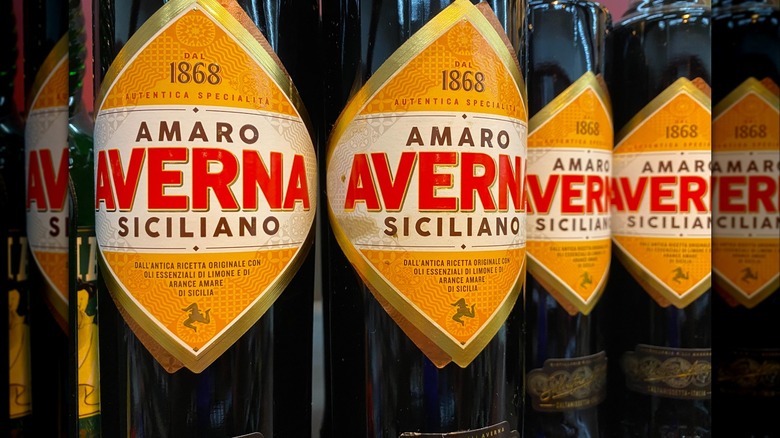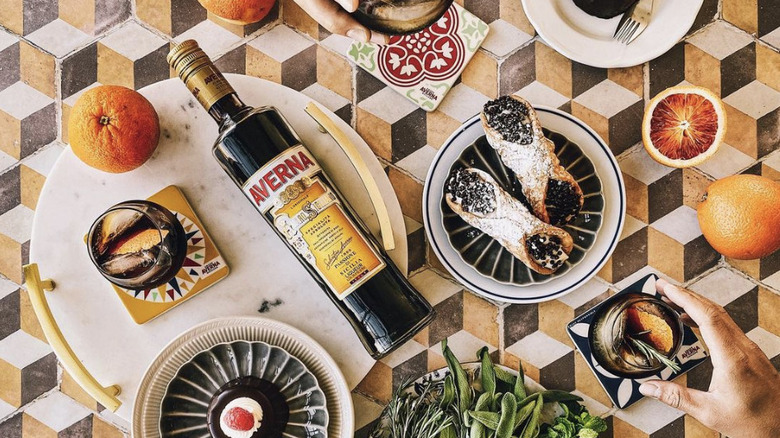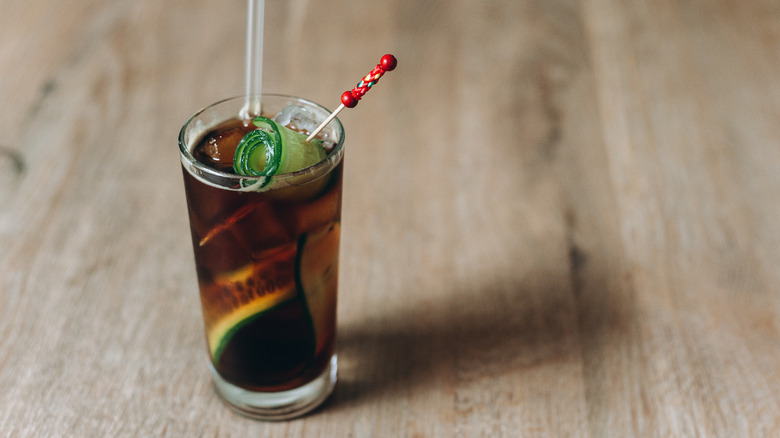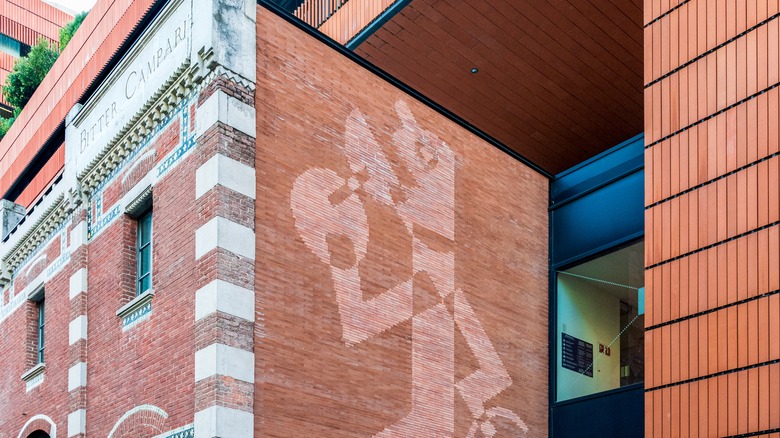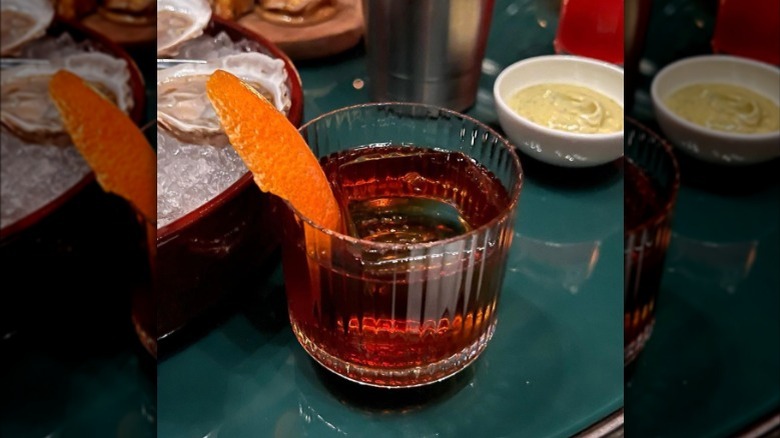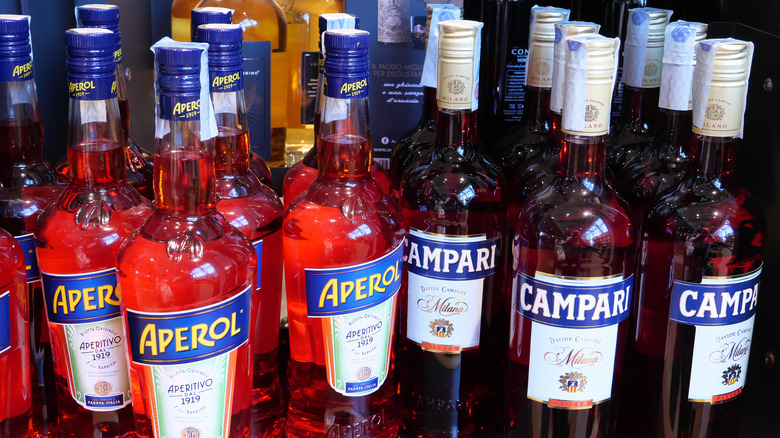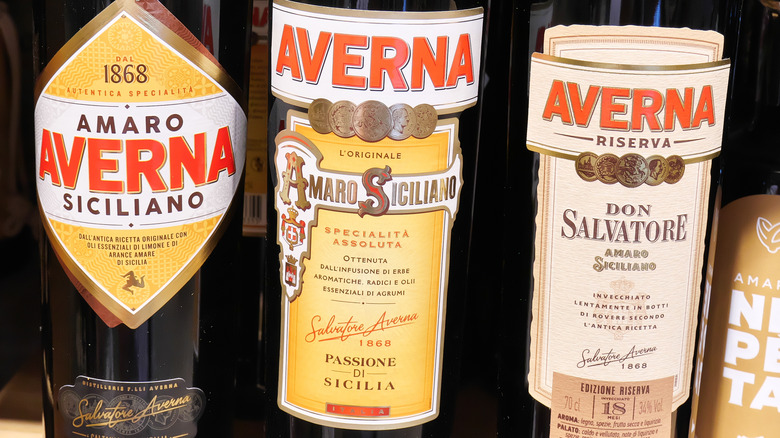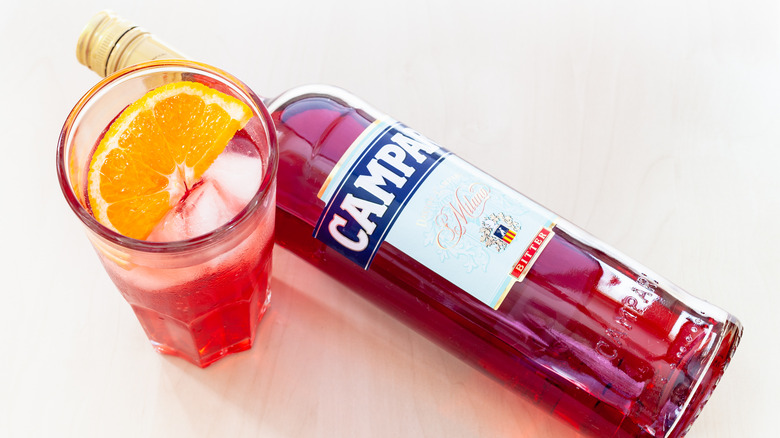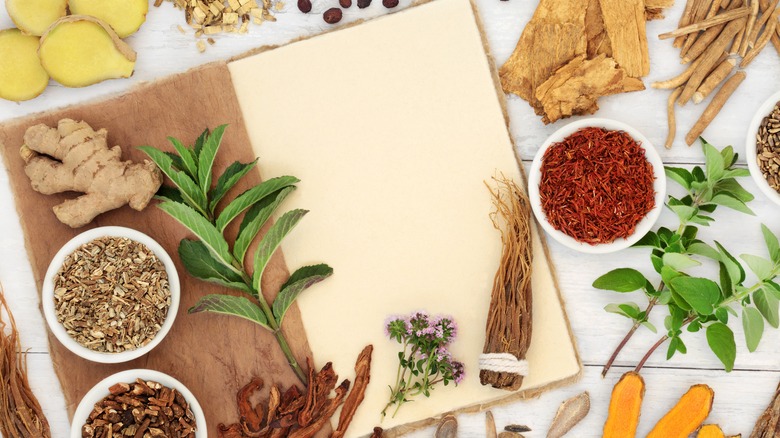All The Facts About Amaro Averna
We may receive a commission on purchases made from links.
Named after its creator Salvatore Averna, Amaro Averna captures the essence of traditional Sicilian amaro — a bittersweet liqueur that typically blends herbs, roots, spices, and flowers. Amaro is said to have been invented by Gaspare Campari in Novara, Italy, in 1860. And as you may have already guessed, Gaspare named his creation Campari, the bright red liqueur that's commonly used in cocktails today.
Amaro Averna was first developed as a digestif, or after-dinner drink, in the late 1800s. In fact, the brand still promotes the spirit as a beverage that's consumed to help savor "the lingering moments after a shared meal." Nevertheless, today the 58% proof liqueur is enjoyed at all times of the day and even added to cocktails. In addition, Amaro Averna has a sweeter and less bitter flavor profile than some other amari, making it great for those who are new to the beverage.
Not sure if Amaro Averna is the drink for you? Keep reading to find out more about this versatile Sicilian liqueur.
History of Amaro Averna
The roots of Amaro Averna can be traced back to the Sicilian town of Caltanissetta, where it was produced in 1868. The story goes that Salvatore Averna, who was an avid philanthropist, was gifted the recipe for the boozy infusion by monks, after he helped to finance the restoration of a church at the Convent of St. Spirito's Abbey. Coming from a well-heeled family, Salvatore could afford such extravagance. He could also afford to later develop and promote the spirit. The recipe for the herbal spirit is believed to have been originally formulated by Benedictine monks at the Abbazia di Santo Spirito, situated in Italy's northern region.
Averna grew in popularity with the help of Salvatore's son, Francesco, who showcased the liqueur at fairs across Italy. By 1895, his efforts helped establish the spirit as one of the most beloved amari in the country. Over the years, Amaro Averna became one of the favorite purveyors of the Royal Household, and in 1912, the company was granted the prestigious right to display the royal crest of arms on its label as a symbol of distinction and honor. A few decades later, in 1958, the Fratelli Averna S.p.A. corporation was established to represent the brand. This, in turn, was acquired by Gruppo Campari in 2014 for around $114 million.
What does Amaro Averna taste like?
Since amaro translates to bitter in Italian, it's no surprise that amari are relatively bitter. Nevertheless, as highlighted by Drinks Straight Up, Amaro Averna is one of the more approachable amari out there, thanks to its sweet caramel flavor. After all, there's a good reason why the liquor is one of the top Amaro sellers in Italy.
The Amaro Averna website describes the digestif as exhibiting "hints of orange and licorice, balanced with notes of myrtle, juniper berries, rosemary, and sage." According to the platform, the liquor also has a relatively thick consistency. Calling Amaro Averna sophisticated in flavor yet very drinkable, Amy Zavatto from Liquor.com is clearly a fan of the digestif, rating it a solid 4 out of 5 stars. More specifically, Zavatto praises the spirit for its harmony of sweet and bitter flavors. She also highlights the drink's versatility, saying that it goes well with mixers, straight over ice, and in cocktails.
How is Amaro Averna made?
Since the recipe for Amaro Averna is a closely guarded secret, we know little about the liqueur's production process. What we do know, however, is that the recipe for the beverage has stayed the same since it was first produced in 1868. We also know that the herbs that give the spirit its unique flavor are still infused in Caltanissetta in Sicily, where Amaro Averna originated, and that the spirit is later transported to the Gruppo Campari facilities, where it's bottled.
According to the Amaro Averna website, the spirit's ingredients are infused with pure alcohol and then combined with water. The concoction is then filtered and merged with additional ingredients such as sugar. While it's unclear whether Amaro Averna is aged, there is an aged version of the liquor called Averna Riserva Don Salvatore. The digestif follows the same recipe but unlike the standard version of Amaro Averna, it's transferred into oak barrique barrels where it stays for 18 months. Throughout the aging process, the flavors of the various ingredients gradually blend and mature, resulting in a more complex and refined taste.
How to drink Amaro Averna
Amaro Averna is a very versatile drink that can be enjoyed in a number of ways. At its simplest, Averna can be served over ice with a twist of a fresh orange peel. To get the most out of the drop, serve it in a curved glass, since this helps to release the drink's aromas. Amaro Averna is also commonly drunk with a splash of soda and can be enjoyed with other mixers.
While there are no classic cocktails that call for Amaro Averna, there are plenty of modern concoctions that utilize the liquor. If you like Aperol Spritz, you are also bound to enjoy Averna Spritz, which combines Amaro, Prosecco, and soda water. Perhaps the best-known cocktail with Amaro, the Black Manhattan replaces sweet vermouth with Amaro and blends it with rye whiskey, Angostura Bitters, and orange bitters. In a similar fashion, Averna Negroni replaces Averna with Campari but incorporates other classic Negroni elements, including gin and sweet vermouth.
Bottle vs. bottle
The Campari Group is behind dozens of popular spirits, including Frangelico, Wild Turkey, Grand Marnier, and Cinzano Vermouth. Besides Amaro Averna, the group produces a number of other amari, including Campari, Aperol, Cynar, and Braulio. As each of the amari is made using a distinct recipe and ingredients, each one possesses its own unique flavor profile. And while all the amari are different, they can all be enjoyed as a substitute for Averna.
Perhaps the best-known of the group's amari, Campari is more bitter than Averna. While Aperol shares Averna's bittersweet taste, at just 11%, it's much lower in alcohol content. The last two offerings include Cynar, which is made using artichoke leaves as well as 12 other herbs and plants, and Braulio, which is aged in Slavonian oak barrels for a minimum of 15 months.
Cocktail Society also offers spirit suggestions that can be used as substitutes for Amaro Averna. If you like your Averna on the rocks, opt for Ramazzotti, which combines the flavors of citrus, licorice, and berries, or the less fruity Amaro Meletti. If you're looking for an Averna alternative to use in cocktails, one of your best bets is Amaro Montenegro. Blending 40 botanicals, the liqueur achieves a sweetness that's similar to that of Averna. Also great in cocktails, Amaro Lucano features a complex bittersweet flavor with prominent hints of spices and herbs.
The Amaro Averna label hides more than meets the eye
Besides its name and Sicilian status, the Amaro Averna label contains some less apparent elements that are representative of the brand's identity and heritage. And while there are different versions of the label, many display the date 1868 when the liquor was first produced, and the signature of its creator Salvatore Averna.
Perhaps one of the most interesting Amaro Averna labels features the Italian royal coat of arms, which the digestif's distiller has been proudly showcasing since being granted the privilege by Vittorio Emanuele III in 1912. The distinction highlights that the second-to-last monarch of Italy had a penchant for the complex flavors of the liqueur. The medals right above the words Amaro Averna are a nod to the awards that the spirit has earned throughout its history. The label also features an inscription in Italian, which translates to the following words: "Absolute Specialties — obtained from the infusion of selected natural plant aromatics. Comes from a secret recipe owned by the Averna family."
Amaro Averna was purchased by Gruppo Campari in 2014
In 2014, Amaro Averna changed hands with the purchase of the Fratelli Averna S.p.A. corporation by Gruppo Campari for around $114 million. According to The Campari Group, one of the reasons behind the purchase was to cement Campari as a powerhouse in the bitter liqueur segment through the acquisition of Averna and Braulio. At the time, both amari were recognized as top players in the Italian bitters game.
Upon purchase, the Campari Group expressed high hopes that the spirit would do well internationally, including in countries such as Germany and the U.S. More specifically, the group considered the increasing popularity of Italian bitters across America. And, according to the man behind the Bitter & Twisted Cocktail Parlour in Phoenix, Ross Simon, the company was right on the money. "Though the word bitter was kind of a taboo thing two or three years ago, now people have warmed up to it. As long as you can explain to your guests what they're drinking and why it's there, they are really receptive," Simon told Market Watch.
The Amaro Averna recipe is a closely guarded secret
Most distillers of amari — including Amaro Averna — keep their recipes closely under wraps. With hundreds of amari types on the Italian market, that's a lot of unknowns. The secret recipe for Amaro Averna obtained by Salvatore Averna over 150 years ago is no exception, with only a select few knowing precisely what goes into the beverage. The production manager at the Averna facility in Caltanissetta, Italy, Piero Fici, takes extraordinary measures to safeguard the recipe from other employees. For example, the sacks of ingredients that arrive at the distillery are devoid of any labels that could be understood by the uninitiated. Instead, they feature specific codewords to ensure that only very few people have information about their content.
Chad Parkhill from The Guardian views this kind of trade secrecy as problematic since he says it discourages tipplers from asking important questions about the composition and origin of these spirits. Fici, who is the only one at the Averna production site who is familiar with its recipe, says that while Amaro Averna is promoted as typically Sicilian, its ingredients don't necessarily come from the island. Instead, they are sourced from suppliers around the world. Interestingly, he also comments that Amaro Averna "could well be produced anywhere else in the world." What that means remains open to interpretation.
Amaro is believed to have medicinal benefits
The infusion of roots, herbs, and spices used to create amaro is known for a variety of health benefits. Traditionally made in monasteries using secret recipes passed down from one generation of monks to the next, amaro has been long known as a digestif. This makes sense from a biological standpoint since our bodies associate bitter flavor — and amaro is bitter — with toxins. This, in turn, stimulates the gut, helping to improve digestion and reduce gastric discomfort.
As with all things, however, both alcohol and amaro's ingredients are best consumed in moderation. The head of beverage development at the Niche Food Group, Meredith Barry, explains, "Particular bitter roots and herbs in high percentages can be dangerous, like quinine, but the right amount, and we only use a tiny amount, is a digestive agent. All of these roots and herbs have healing properties at some level, in moderation."
While amaro may very well be a digestif, in the past the bitter liqueur was also believed to have other therapeutic qualities, depending on its content. Amari with cinchona bark, which contains quinine, were used to reduce the risk of malaria, while amari with ginger, cloves, or chamomile were used to alleviate inflammation.
Amaro Averna gets the thumbs-up from tipplers
Amaro Averna is one of the world's most popular Italian amari, and for a good reason. The herbal concoction has been praised by consumers not just in the country of its origin, but also in the U.S. As an aside, Americans love amaro so much that producers in the country have been increasingly creating their own versions of the herbal elixir.
With Amaro Averna's deep flavor profile, it's little wonder that the liqueur has done so well with Amazon and Drizly shoppers, scoring 4.9 out of 5 stars on both platforms. One happy Drizly buyer explains why he loves Amaro Averna, saying, "Underlying sweetness to a complex herbal palate makes this a great intro to those just getting into amaro. Great conversation starter. Good neat or on the rocks, especially after a big meal." Other Drizly reviewers second this opinion, commenting, "The perfect amaro for spritzes and mixing with bourbon," "Delicious," and "Makes a great Black Manhattan."
Static Media owns and operates Mashed and Tasting Table.
